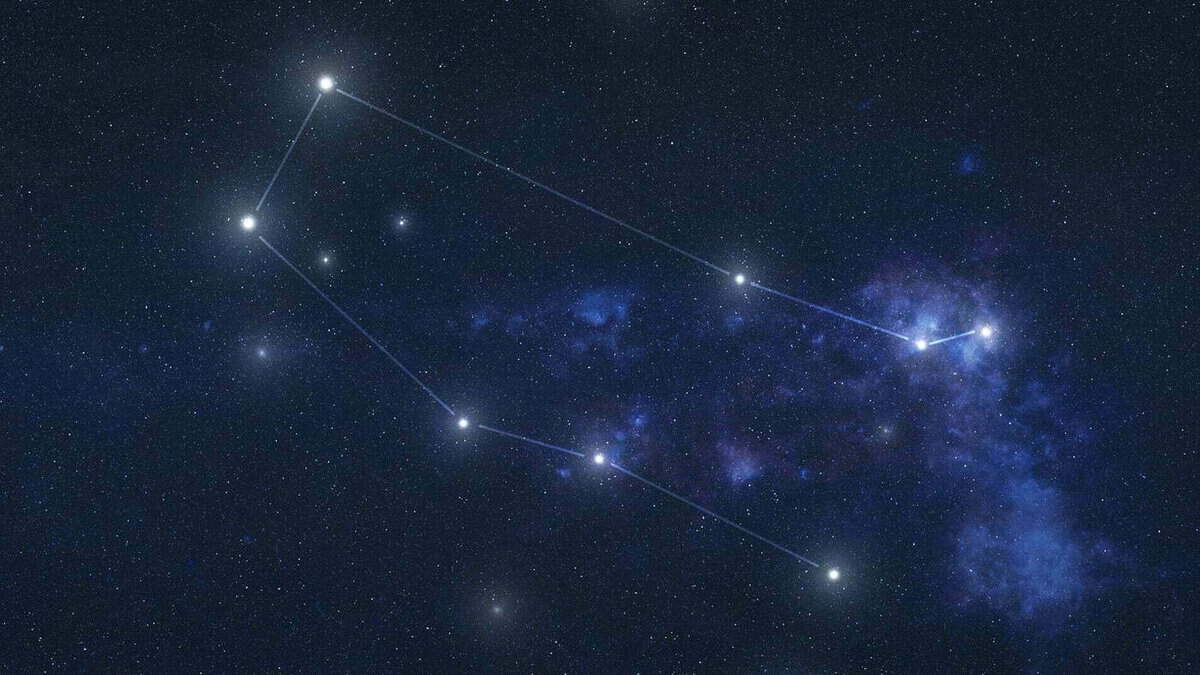
- Constellations
Gemini is a constellation located in the northern hemisphere of the sky. It is known for its bright stars, Pollux and Castor. The Sun is positioned within this constellation from June 20th to July 20th.
The primary celestial bodies of the Gemini constellation
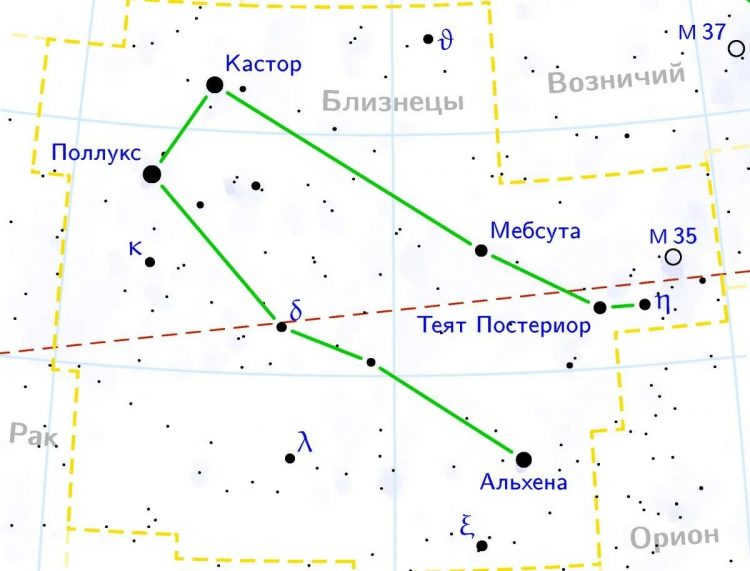
Castor (Alpha Gemini)
Castor (Alpha Gemini) – represents a group of six stars that are gravitationally bound to one another. They collectively have a stellar magnitude of 1.59 and are located at a distance of 45 light years from our Sun. It is the second brightest star in the Gemini constellation and the 44th brightest star in the sky.
The two prominent blue-white stars of Castor have stellar magnitudes of 2.7m and 2m respectively, and are in fact a binary system. They orbit around a common center of mass with an angular separation of 6″, completing one revolution in about 400 years.
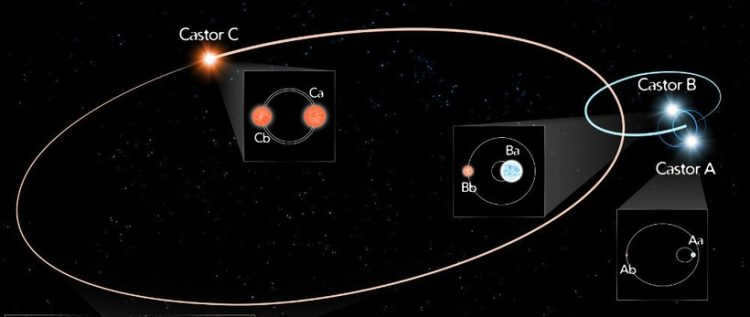
In Arabic culture, it was referred to as “The leader of the Great Twin.”
Observation
As early as 1804, Herschel observed the apparent orbital movement of this celestial body, which today has a period of 341 years according to current data. It was the first binary star system discovered. The distance between these celestial bodies is 76 astronomical units (a.u.).
The A and B components of Castor also have a neighboring star, Castor C, located 73″ away from them. Castor C is a small red dwarf star and has a spectral double.
Pollux (Gemini Beta).
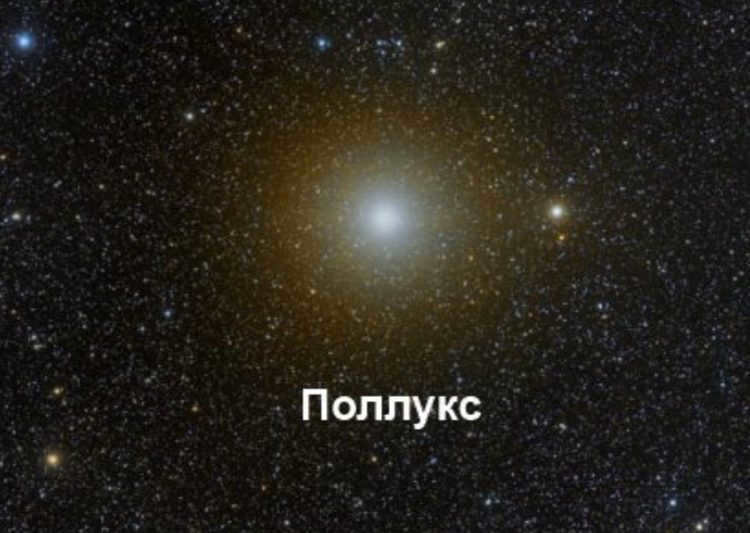
Pollux (Beta Gemini). – is a solitary, cooled orange giant star (K0 III) with a visual magnitude of 1.14 and a distance of ZZ.78 light-years. It is the brightest star in the constellation and the 17th brightest in the night sky. It has a mass twice that of the Sun and a radius nine times greater. It is sometimes referred to as the “Head of the Second Geminia”.
In June 2006, astronomers observed an exoplanet in orbit around Pollux. This exoplanet, named Pollux b, has a mass 2.Z times that of Jupiter and an orbital period of 590 days.
Alchena (also known as Gemini Gamma)
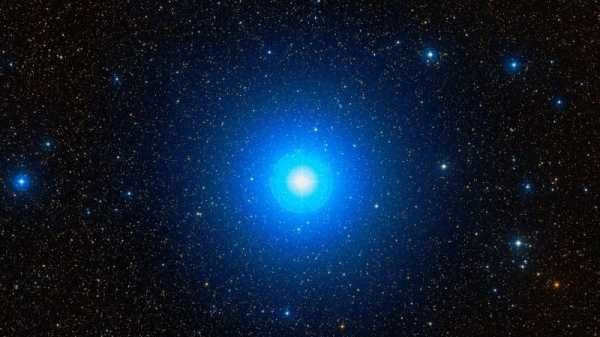
Alchena (Gemini Gamma). – An A1 IV white subgiant, with a mass of 2.8 solar masses and a radius Z.Z times that of the Sun. It has an apparent visual magnitude of 1.915, making it 12Z times brighter than the Sun and visible without the need for technology. This star is located approximately 109 light-years away from Earth.
The star’s traditional name, Alhena, originates from the Arabic term Al Han’ah, which means “brand” and refers to the brand on a camel’s neck. It is also sometimes called Almeisan, derived from the Arabic term Al Maisan, meaning “shining.”
Mebsut (Epsilon Gemini)
Mebsut, also known as Epsilon Gemini, is a star system located in the constellation Gemini. It consists of two stars, both of which are main sequence stars. Mebsut A is a blue-white star, while Mebsut B is a yellow-white star. The two stars orbit each other with a period of about 118 days.
Mebsut is relatively close to Earth, with a distance of about 600 light-years. It is visible to the naked eye and has a combined apparent magnitude of 3.06. The system has been studied extensively by astronomers, who have used it as a benchmark for understanding stellar evolution and binary star systems.
The name “Mebsut” is derived from the Arabic word for “the outstretched paw,” which refers to the position of the stars in the constellation Gemini. Epsilon Gemini is one of the brightest stars in the constellation and is often used as a reference point for locating other celestial objects in the night sky.
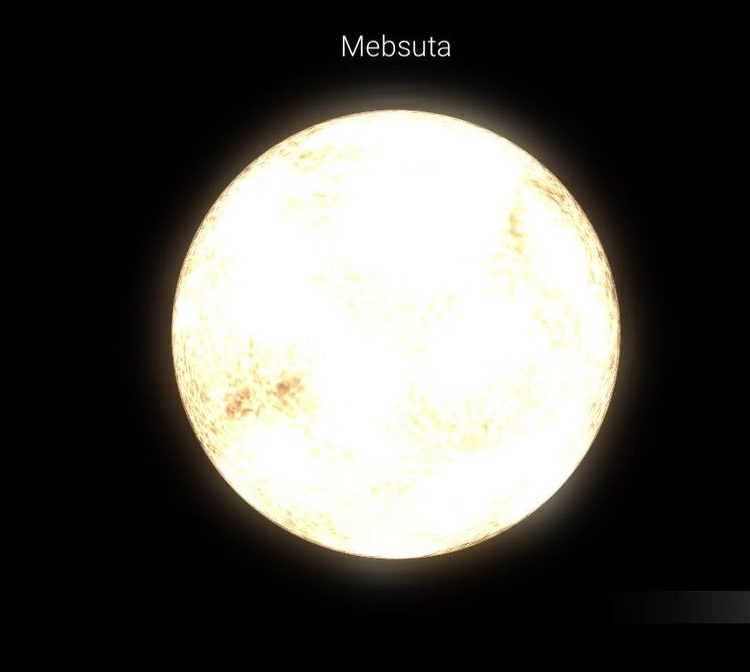
Mebsut (Epsilon Gemini). – represents a supergiant (G8 Ib) with a visible brightness of Z.06 and a distance of approximately 840 light-years.
Mebsut is approximately 8,500 times more luminous compared to the Sun and possesses a mass that is 19 times greater. The star’s radius spans from 105 to 175 times the radius of the Sun.
It holds a position in close proximity to the ecliptic, making it susceptible to being obscured by the Moon and other planets. Mebsut is specifically situated in the right leg of Castor. The name “Mebsut” originates from the ancient Arabic term Mabsula, meaning “outstretched paw”. According to Arabic culture, Epsilon and Zeta Gemini symbolize the paws of a lion.
Teyat (Mu Gemini)
can be restated as:
Teyat (Mu Gemini)
is another name for the star Mu Gemini.
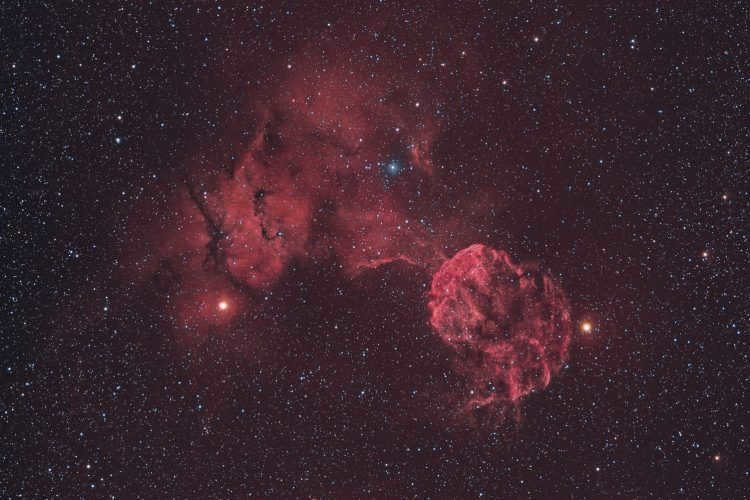
Myu Gemini is located to the left and surrounded by the S249 nebula.
Myu Gemini is known as the fourth brightest star in the Gemini constellation. It has an apparent magnitude of 2.857 and is approximately 230 light-years away from our planet. This star belongs to the spectral class M3 III, indicating that it is a red giant.
Tejat Posterior has a mass that is 2.1 times greater than that of the Sun. It is also 80 times larger in radius compared to our own star. The surface temperature of Myu Gemini is 3,100º C, and its luminosity is 15% brighter than that of the Sun. In traditional terms, it is known as “Tejat Posterior” or the “posterior leg,” representing the foot of Castor. In Latin, it can be associated with the word “Calx,” meaning “heel.”
This particular celestial object is known as Gemini.
Gemini is a star system that consists of three stars and is located approximately 50 light-years away. The system is composed of a spectroscopic double star and a dwarf star (G0) that orbits the double star every 700 years. Due to its proximity to the ecliptic, Gemini can potentially be occulted by the Moon or other planets.
The primary star in the Gemini system is a semiregular variable star, meaning its luminosity changes over a period of 24 days. It is classified as a red giant (MZIIIlab) and its magnitude varies between Z.15 and Z.9. The second component of the system is a star (B) that has an orbital period of 8.2 years.
Vasat (Delta Gemini)
Vasat, also known as Delta Gemini, is a star system located in the Gemini constellation. It is a binary star system consisting of two main sequence stars, Vasat A and Vasat B. The two stars orbit each other in a close binary system, with a period of approximately 3.5 days.
Vasat A is the larger and hotter star of the pair, with a mass of approximately 1.5 times that of the Sun. It has a spectral type of F9V and a surface temperature of around 6,000 Kelvin. Vasat B is smaller and cooler, with a mass of about 0.9 times that of the Sun. It has a spectral type of G2V and a surface temperature of about 5,500 Kelvin.
The two stars in the Vasat system are relatively young, with an estimated age of about 200 million years. They are both still in the main sequence phase of their evolution, meaning they are generating energy through nuclear fusion in their cores.
Vasat A and Vasat B are separated by an average distance of about 0.1 astronomical units (AU), which is roughly the distance between the Earth and the Sun. This close proximity allows for significant tidal interaction between the two stars, causing them to become tidally locked and synchronized in their rotation.
The Vasat system is visible to the naked eye from Earth, with an apparent magnitude of about 4.3. It is located at a distance of approximately 59 light-years from our solar system.
Overall, the Vasat system is an interesting binary star system that provides valuable insights into the evolution and dynamics of binary star systems. Its relatively close proximity and visibility make it a popular target for astronomers studying stellar evolution and stellar dynamics.
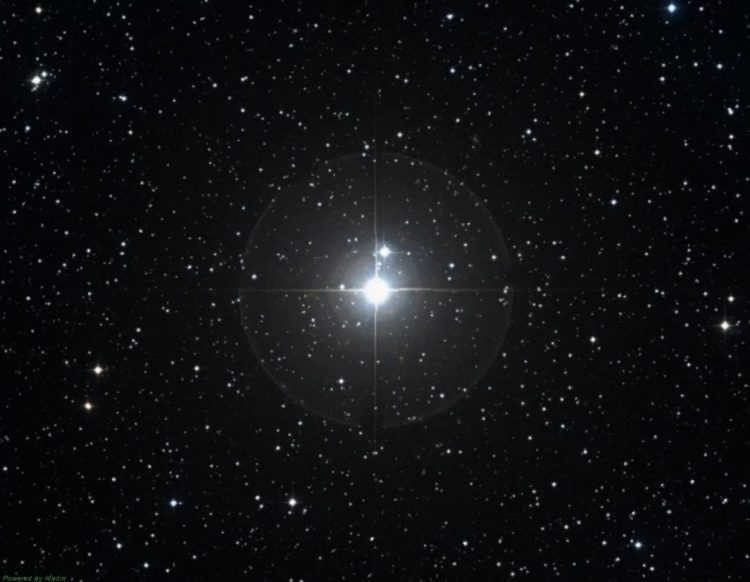
Vasat (Gemini Delta). – is a subgiant of yellow-white color (F0 IV) with a magnitude of Z.5Z (visible to the naked eye) and a distance of 60.5 light-years. It is situated to the south of the ecliptic and can occasionally be obscured by the Moon and planets.
The Arabic word “Wasat” signifies “middle”.
In 19Z0, the American astronomer Clyde Tombaugh discovered Pluto just 0.5° to the east of this star.
This star system consists of three stars. The inner stars create a spectroscopic double system, with the components revolving around each other every 6.1 years.
There is also a companion star of the K-class that orbits every 1200 years and is observable with a small telescope. It has a rotational velocity of 129.7 km/s and an estimated age of 1.6 billion years. In approximately 1.1 million years, this star will come within a distance of 6.7 light-years from the Sun.
Gemini’s Xi Star
Gemini’s Xi star is classified as a yellow-white subgiant (F5 IV) with a visual magnitude of Z.Z5 and a distance of 58.7 light-years. It shines 11 times brighter than the Sun and rotates at a high speed, reaching 66 km/s. It is believed to be a spectroscopic binary, consisting of two closely orbiting stars.
The star is traditionally known as “Alzirr,” which translates from Arabic as “button.” It is one of the four stars that mark the legs of the Gemini constellation. Its brightness makes it visible to the naked eye.
Gemini’s Kappa Star
Gemini Kappa is a multiple star system (G8 IIIa) located 14Z light-years away from our solar system. It has an apparent magnitude of Z.57, making it 78 times brighter than the Sun.
Star Lambda in Gemini
Gemini Lambda is a variable star (AZ V) with an apparent magnitude of Z.58 and a distance of 94.Z light-years. It is 28 times brighter than the Sun and has a radius 2.8 times larger and a mass 2.1 times larger. It is estimated to be around 800 million years old.
Propus (Iota Gemini)
Propus (Iota Gemini) is a variable star with a G9III spectral classification. It has an apparent magnitude of Z.78 and is located Z26 light-years away. The name “Propus” is derived from the Latin term “front paw.”
Mekbuda (Zeta Gemini)
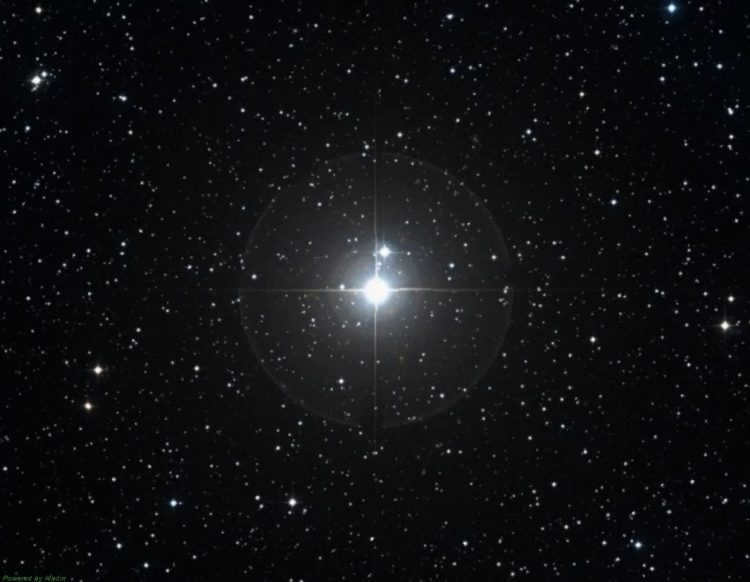
Mekbuda (Zeta Gemini) is an intermediate supergiant and variable star. It is a renowned Cepheid. These types of stars are 4-20 times more massive than the Sun.
With a brightness 2,900 times that of the Sun.
Typically, they are yellow supergiants (F6-K2) that experience fluctuations in brightness due to pulsation periods lasting from a few days to months. The frequency of these pulsations depends on the mass of the star.
The name “Mekbuda” comes from ancient Arabic and means “folded paws of a lion”.
Tau Gemini
Tau Gemini is an orange giant star (K2 III) that has an apparent visual magnitude of 4.42 and is located approximately 21 light-years away. Under favorable weather conditions, it is possible to observe the star without the need for any astronomical instruments.
This star has twice the mass of our Sun, is 27 times larger in radius, and is 224 times more luminous. It has a companion known as the brown dwarf Tau Gemini b, which has a mass equivalent to 18.1 times that of Jupiter. Tau Gemini b was discovered in 2004 and takes approximately 5 days to complete its orbit around Tau Gemini.
U of Gemini
U of Gemini is a dwarf nova that consists of a white dwarf and a red dwarf in orbit around each other. Every 100 days, the star goes through a period of flaring, resulting in a significant increase in brightness. The visual magnitude of the star ranges from 14.0 to 15.1, but during a flare-up, it can reach a magnitude of 9, making it 100 times brighter than usual. The period of these flares is irregular and can last anywhere from 62 to 257 days.
The U of Gemini system is located approximately 400 light-years away from the Sun.
It was first observed in 1855 by the English astronomer John Russell Hyndom during one of its flares. The orbital period of the two dwarf stars is 4 hours and 11 minutes, which contributes to the variability of the system. Each time they orbit around each other, they outshine one another.
Fascinating things to observe
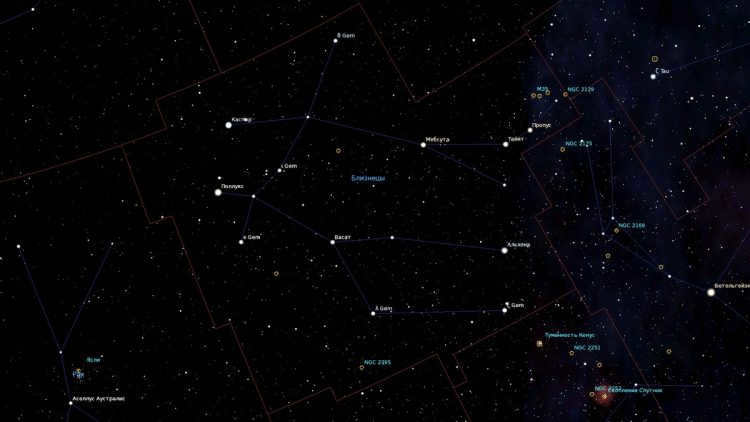
When it comes to observing dispersed star clusters, there is no need for sophisticated equipment. The most suitable tools for this task are binoculars or a telescope. By utilizing low magnification, one can easily observe and tally up a multitude of luminous stars.
1. The Dispersed Star Cluster M 35 (NGC 2168)
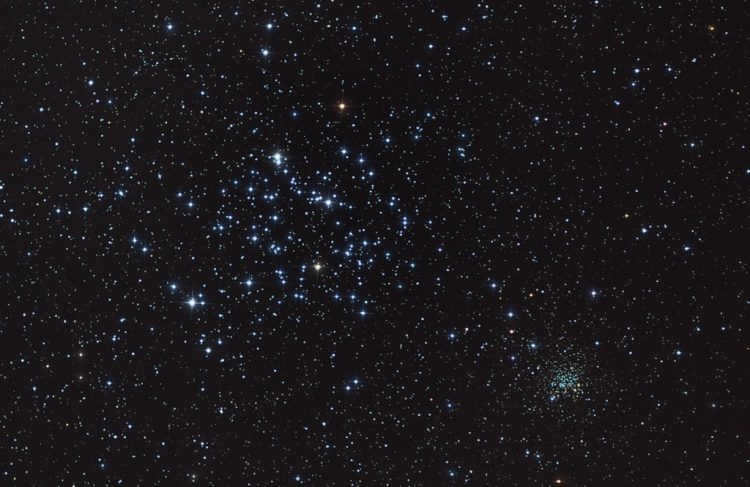
Bright diffuse star cluster M 35 contains approximately 120 stars of spectral class B. Its total brightness is 5.1m. These clusters are a great way for beginners to learn how to navigate the night sky, as they highlight and help to memorize popular objects in the starry expanse.
M 35 is situated 2,800 light-years away from the Sun and spans an area of 28 light-years.
It can be found near the “foot” of the Gemini constellation, making it easy to locate. To begin your search, you can use two bright stars, Pollux and Castor, as reference points and move downward to the star Teyat. Just to the right, you will see a large cluster of stars, which is M 35.
2. NGC 2158: A Dispersed Stellar Group
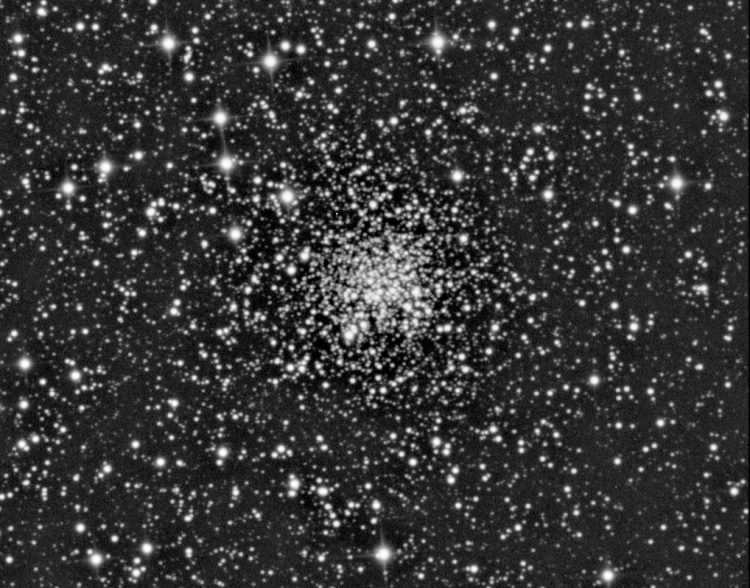
The scattered group NGC 2158 exhibits a smaller angular size of 5′ and lower brightness of 8.6m in comparison to its neighboring cluster M 35. At first glance, it may appear to be a globular cluster rather than a scattered one. However, a closer examination at higher magnifications dispels any doubts.
When observed with wide-angle eyepieces at low magnifications (up to 50x), both clusters comfortably fit within the same field of view and present a magnificent sight.
3. A duo of dispersed star clusters, IC 2156 and IC 2157
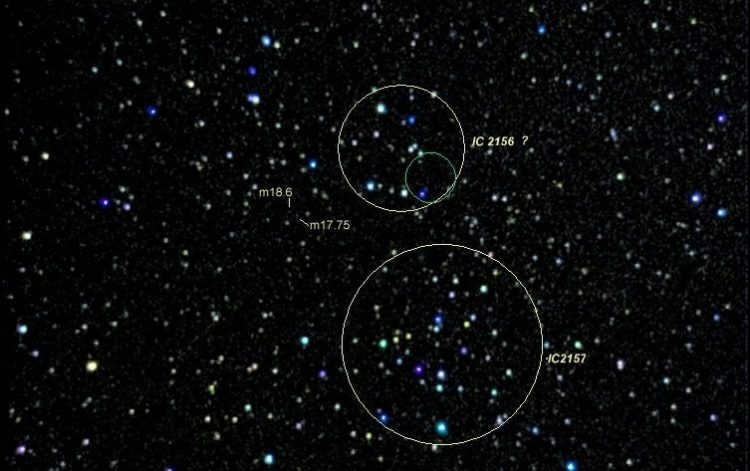
At low magnifications in the telescope’s eyepiece, it is not easy to distinguish two clusters with a combined brightness of 8.6m and angular sizes under 10′. The reason for this is that the stars in this part of the sky are closely intertwined and all have a magnitude of 7-8. As shown in the photograph, there is no distinct boundary between the clusters, likely IC 2156 and IC 2157, which consist of approximately 60 stars, with the brightest barely reaching a magnitude of 9.
In search of a similar location to the previous two clusters, they can be found in the “left leg” to the north of the nearby brother.
4. NGC 2129: A Dispersed Star Cluster.
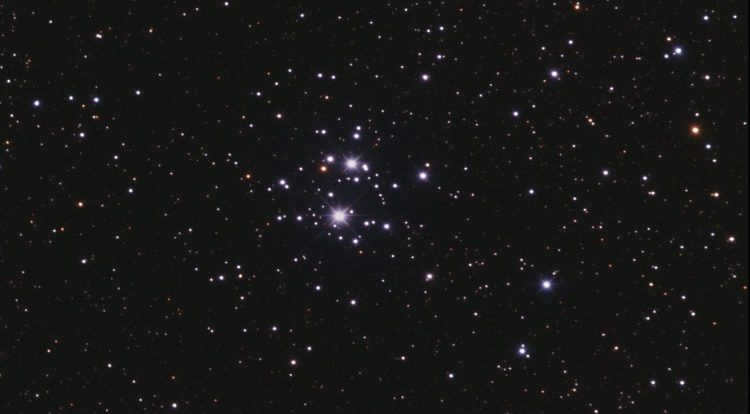
NGC 2129 is a dispersed cluster that can be found on the border of the Taurus and Orion constellations. Within this cluster, there are over 25 stars with varying brightness levels ranging from 7 to 11 stellar magnitudes, resulting in a total luminosity of 6.7m. The angular size of NGC 2129 measures 7′.
By utilizing a telescope with a magnification of 100+, it is possible to fully separate the stellar components within the cluster and even discern their different shades. The brightest stars appear as a vibrant yellow, while the ones with lower brightness exhibit a bluish tint.
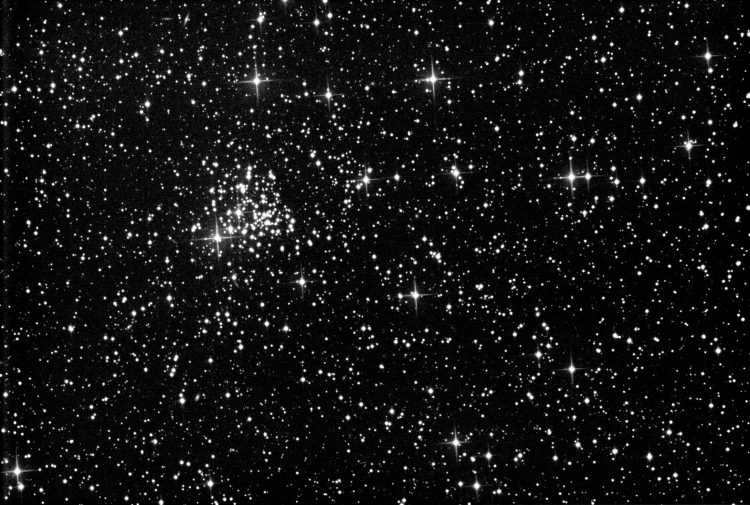
There is a complex sequential new number that poses a significant challenge for both search and detection. It is the scattered star cluster NGC 2266, which has an angular size of 7′ and a brightness of 10m. I suggest starting the observation by focusing on the bright star Mebsut (ε Gem) and gradually adjusting the telescope tube upwards.
6. Dispersed star cluster NGC 2331
A scattered star cluster known as NGC 2331 consists of several prominent stars with magnitudes ranging from 9 to 10. This cluster has an angular size of 18′ and a brightness of 9m. Various calculations estimate that the cluster contains between 15 and 25 stars.
7. NGC 2355: An Uncommonly Dispersed Star Cluster
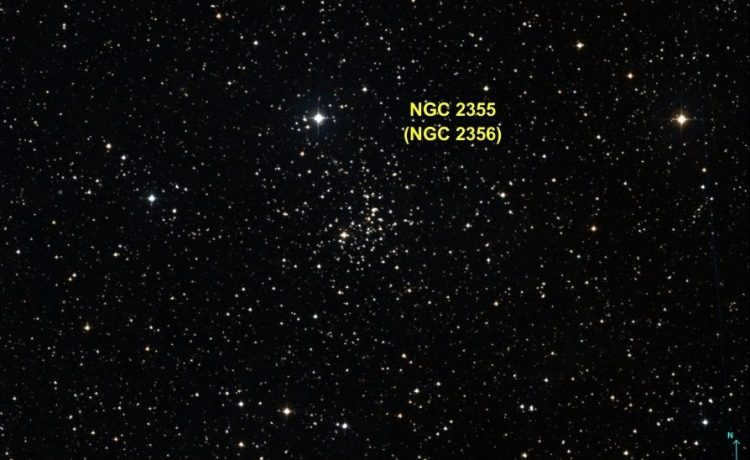
In the southern part of the Gemini constellation, located near the boundary with the Small Dog constellation, there are a few more scattered clusters, including one known as NGC 2355. This cluster has an angular size of 9 minutes and a relatively dim brightness of magnitude 10. When observing through a 10-inch telescope at a magnification of 70-90x, it is possible to discern its varied structure and confirm that it is indeed a scattered cluster.
By increasing the magnification to 120+, it is possible to further resolve the cluster into individual components. However, the color of the stars cannot be distinguished due to their relatively low magnitudes, with none exceeding magnitude 13.
To locate NGC 2355, begin your search from the star λ Gem and descend towards the horizon.
8. NGC 2395: A Dispersed Star Cluster
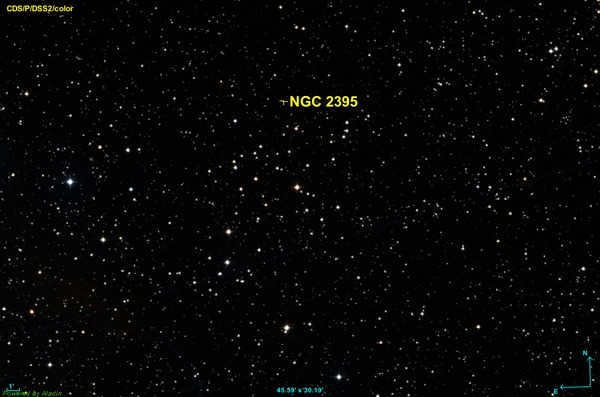
The next star cluster in the southern hemisphere is NGC 2395. NGC 2395 has a magnitude of 8m and spans an angular size of 12′. I was able to observe around twenty-four stars with magnitudes ranging from 8 to 11 within the cluster, but the exact number of stars remains unknown.
9. Eskimo Planetary Nebula (NGC 2392 or C 39)
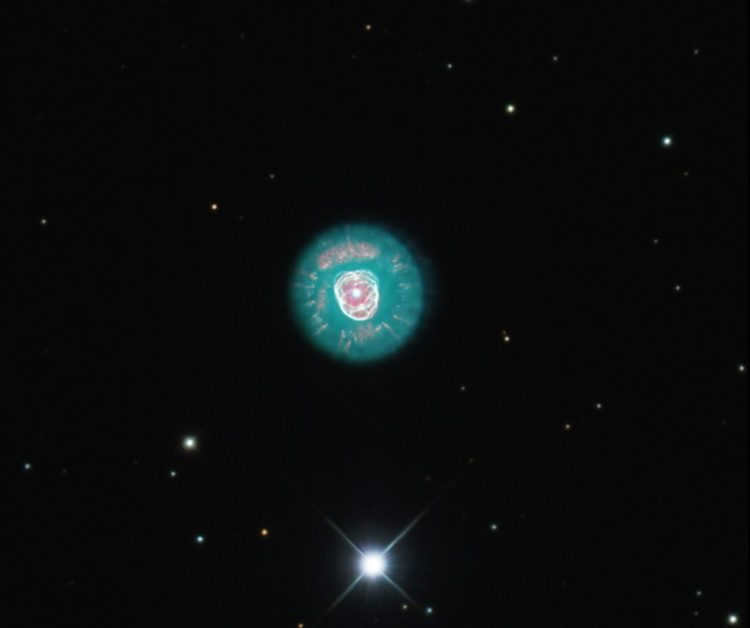
Challenging to observe yet incredibly stunning is the planetary nebula known as the “Eskimoс” (also referred to as NGC 2392 or C 39 in the Caldwell catalog). It possesses a magnitude of approximately 8.6m and is situated around 2900 light-years away from our Sun, exhibiting an apparent size of 0.9′.
An extraordinary star with a luminosity of 9m resides at the core of this nebula. This star can be observed through a professional-grade telescope.
To locate this nebula, one can rely on two prominent stars within the Gemini constellation, namely Castor and Pollux. Trace your gaze downwards to the radiant star known as Vasat, which boasts a luminosity of 3.5m. From there, gradually shift your attention towards the left side until you come across a faint patch – and there you will find our “Eskimo” nebula.
10. NGC 2420: A Dispersed Stellar Cluster
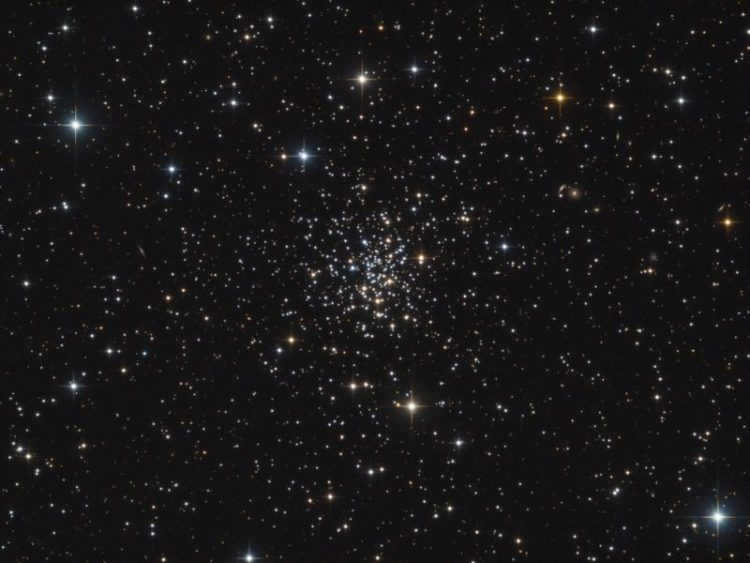
The brightness level of the NGC 2420 cluster is 8m, and it has an angular size of 10′. This particular cluster is situated in a region of the constellation that is considered to be “blind”, meaning that there is a low concentration of stars in this area. It is comprised of approximately 60 stars with a stellar magnitude ranging from 10 to 16.
By using a wide-angle eyepiece, one can observe the structure of the cluster and the uneven distribution of stars within it.
Gemini is a constellation of the zodiac. The best time to observe it is during the night from December to May. Gemini is located near the constellations of Cancer, Canis Minor, Vulpecula, and Lynx. A portion of Gemini is situated within the Milky Way. This constellation can be seen all across Russia.
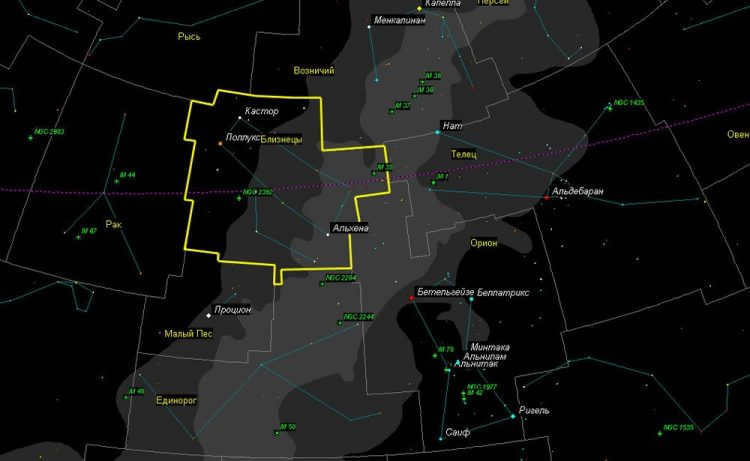
On a clear and moonless night, the constellation Gemini offers the naked eye a spectacle of approximately 70 stars, with 14 of them shining brighter than the third magnitude.
One can’t help but be drawn to this constellation by the presence of two close-knit bright stars – Pollux and Castor.
The other prominent stars in Gemini form two rows, with fainter stars branching off like chains. However, it’s challenging to discern the ancient depiction of the constellation as twin brothers in the geometric figure found in star atlases and maps.
Origin of the Gemini constellation
The Gemini constellation is among the most ancient constellations known to humanity. The knowledge of this celestial formation dates back to the 2nd century AD, as indicated in the surviving monograph called “Almagest” by Claudius Ptolemy.
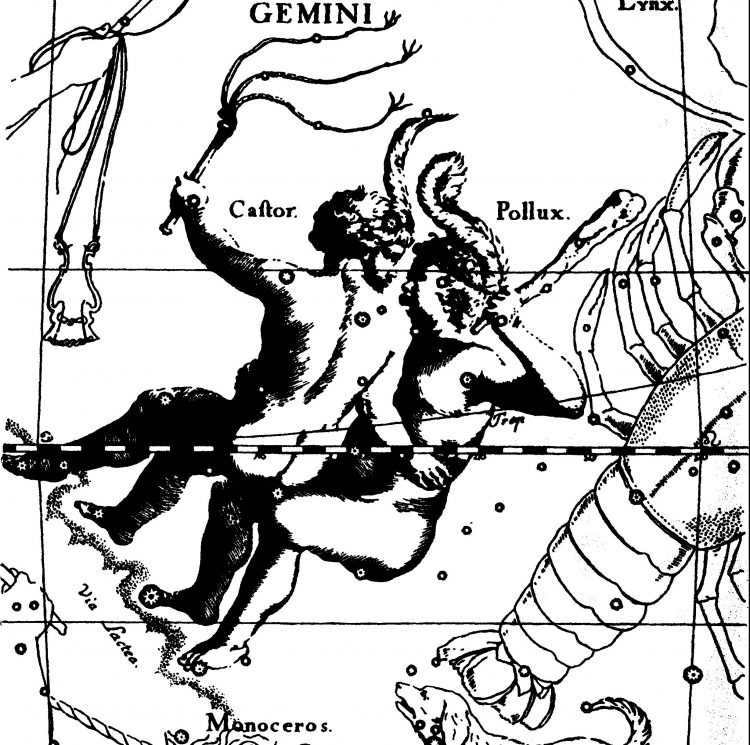
However, the constellation was definitively named “Great Gemini” in texts from the Persian and Seleucid periods. In Russian literature from the XVI century, for example, in the “Meeting of Divine Affairs,” the constellation was referred to as “twin.”
In the history of astronomy, this constellation is famous for two major discoveries. In 1781, William Herschel discovered the planet Uranus near the star Propus, and in 1930, Clyde Tombaugh discovered Pluto near the star Vasat (δ Gemini).

According to Greek mythology, the primary stars of the constellation are Castor and Pollux, representing a pair of twin brothers. They were born to the queen of Sparta, Leda, renowned for her beauty that even the god Zeus couldn’t resist. To avoid being recognized by his divine wife Hera, Zeus transformed into a swan and entered Leda’s chamber through the window. As a result, Leda gave birth to Pollux and Helen. Pollux is also known as Polydevcus, the name given to him by the Romans.
Simultaneously, Leda gave birth to two more children – a son named Castor and a daughter named Clytemnestra. However, their father was Leda’s lawful spouse, the king of Sparta named Tyndarus. Consequently, Castor was a mortal man, while Pollux was immortal due to his divine parentage.
Castor and Pollux were raised side by side and ultimately achieved great renown as heroes. They took part in the renowned voyage of the Argonauts and achieved numerous remarkable deeds. Pollux gained fame as an exceptional pugilist, while Castor excelled in horsemanship and swordsmanship – according to legend, he even trained Hercules himself. The twins harbored a deep affection for one another and were inseparable.

However, tragedy struck one fateful day. Castor and Pollux had two twin cousins named Linkeus and Id. During a heated argument, Id fatally wounded Castor with a spear. Pollux engaged in a fierce battle with Id, but their strength was evenly matched, resulting in a prolonged struggle. Eventually, Zeus intervened by hurling a thunderbolt that struck down Id, the wrongdoer.
The grief that consumed Pollux was so immense that he beseeched his divine father to strip him of his immortality, so that he could join his brother in the underworld realm of Hades. After much deliberation, a compromise was reached – Pollux would spend one day with his brother in Hades, and the following day, they would both ascend to Mount Olympus to join the gods.
This is the story of how the brothers ascended to the heavens, transforming into celestial bodies that serve as a reminder of the enduring bond of brotherly love. In ancient Greek mythology, they were revered as divine beings who safeguarded travelers from all perils in foreign lands.
Astrology
Gemini – The third astrological sign in the zodiac. It succeeds Taurus and spans the sector of the ecliptic from 60 ° to 90 °, relative to the vernal equinox;
In Western astrology, the Sun is said to be in Gemini approximately from May 22 to June 21. It should be noted that Gemini should not be conflated with the constellation Gemini, where the Sun is in Gemini from June 20 to July 20.
Due to the distinctive shape of its symbol, this sign is sometimes referred to as the “butterfly” of the Zodiac.
Video
can be paraphrased as
Visual Content
Currently, there are additional cumulative discounts (ranging from 2% to 25%) offered to 58,750 educational establishments. To determine the applicable discount for all staff members of your educational institution, please access your personal Infoworks account.


Professional retraining program
The principles and techniques of teaching at a children’s art school.
In addition to this offer, we can also apply the discount provided by your educational institution (the amount of discount depends on the number of your colleagues who have completed Infoworks courses).
Currently, there are additional discounts (ranging from 2% to 25%) available to 58,750 educational institutions. To find out the specific discount applicable to all employees of your educational institution, please log in to your personal Infoworks account.


Course for professional growth
Ensuring security against terrorism
We can apply the discount of your educational establishment to this offer (it depends on how many of your colleagues have completed Infoworks courses)
Currently, there are additional progressive discounts (ranging from 2% to 25%) available to 58,750 educational institutions. To find out what discount is applicable to all staff members of your educational establishment, please log in to your personal Infoworks account.


Unique Characteristics of Learning and Adjustment to School for Children with EE at the Start of the Academic Year
Outline of the Presentation Slides:

Slide 2 BLISNECKS is a constellation in the zodiac.
It offers its best viewing opportunities during the nighttime period from December to May. Located nearby Gemini are the constellations of Cancer, the Lesser Dog, Volopassus, and Lynx. A section of the Gemini constellation is situated within the Milky Way.

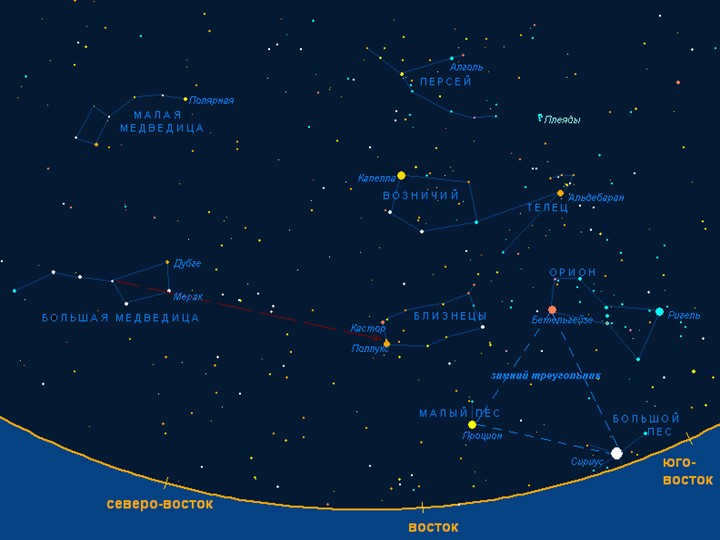
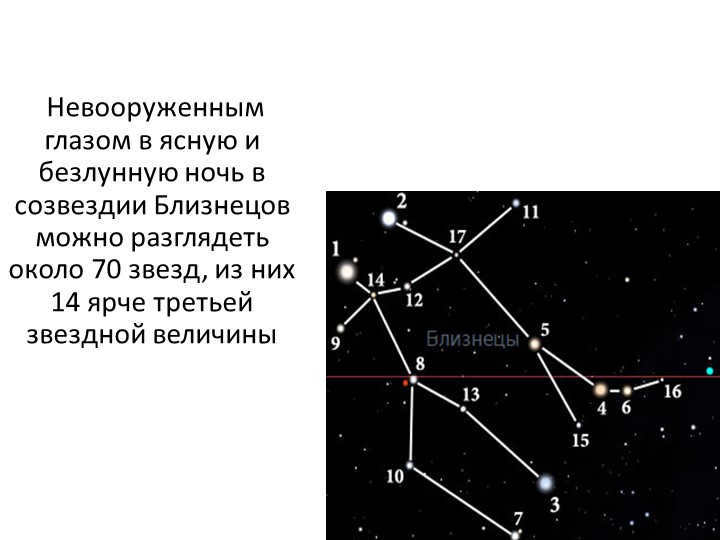
On a cloudless, moonless night, the constellation Gemini reveals around 70 stars visible to the naked eye. Among them, 14 stars shine brighter than the third magnitude.
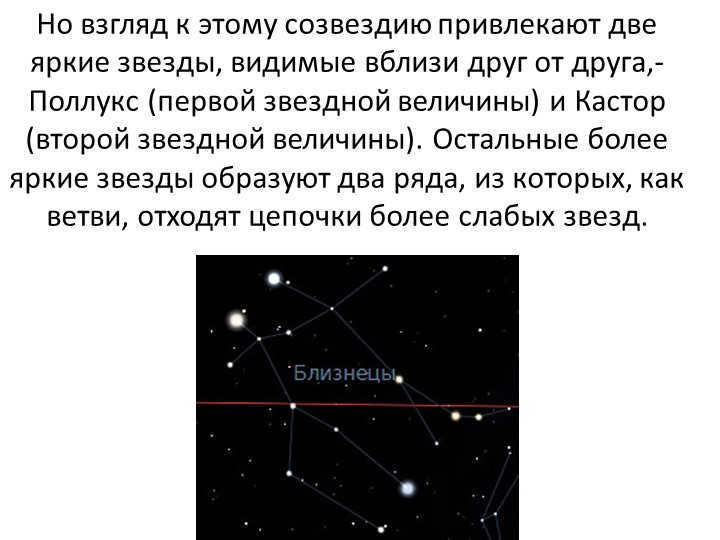

Slide number 6: Nevertheless, one’s gaze is captivated by this constellation due to the presence of two brilliant stars that can be seen in close proximity – Pollux (with a magnitude of one) and Castor (with a magnitude of two). The remaining stars, which are brighter, are arranged in two rows, from which fainter stars extend outwards like the branches of a tree.
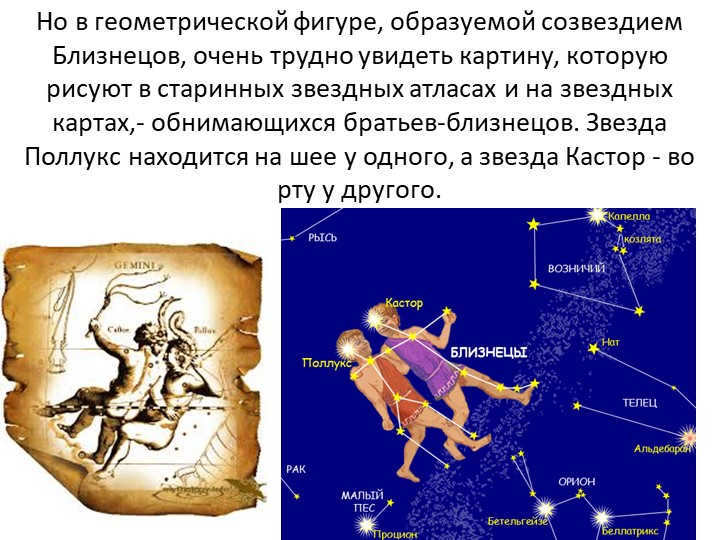

On the seventh slide, within the geometric shape created by the constellation Gemini, it is extremely difficult to perceive the picture illustrating twin brothers that can be found in ancient star atlases and star maps. One of the stars, Pollux, is located on the neck of one brother, while the other star, Castor, is positioned in the mouth of the other brother.


Slide 8: Within the constellation of Gemini, there exists an array of captivating objects, a few of which are observable without the aid of a telescope.
Among these objects is the star κ Gemini, which belongs to the category of bright and exquisite double stars. The primary star possesses a magnitude of Zm,6. Positioned at an angular distance of 7" from it is a companion star with a magnitude of 8m. When observed through a telescope, κ Gemini offers a breathtaking spectacle: the two stars appear as if they are sparkling gems side by side. One emits a radiant orange light while the other emits a vibrant green light.
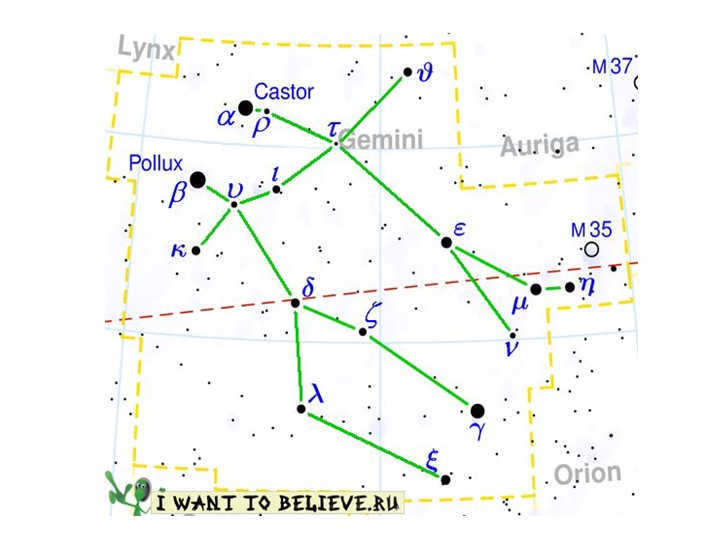



12 slide To avoid being separated from his brother, Pollux made the choice without hesitation. Ever since, the brothers have been inseparable once again. They spent one day in the underworld of Hades among the shadows of the deceased, and the next day they ascended to the heights of Olympus in the palaces of Zeus, the god of thunder, and celebrated with all the other gods at lavish festivities.
The ancient Greeks revered the twin brothers as deities who protected people from all troubles and dangers, and watched over them during their travels in Greece or faraway foreign lands.
The bond between Pollux and Castor became the epitome of brotherly love. Zeus, the ruler of heaven and earth, transformed the twin brothers into stars and let them shine in the sky among the other constellations, serving as a reminder to people of true brotherly love.
- Portfolio testimonials
- Unlimited access for only 99 rubles
- Over 3,800 video lectures available to all
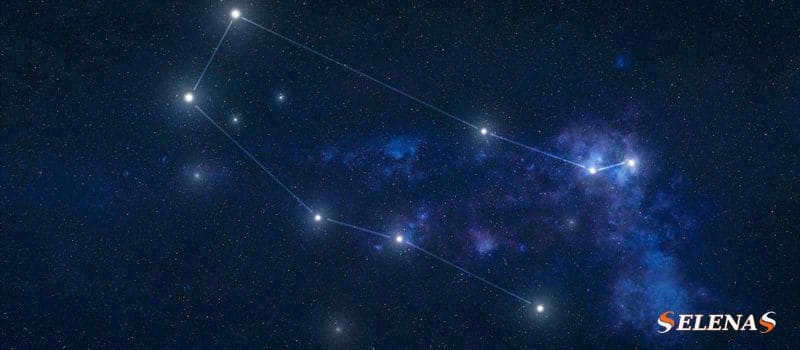
Continuing my series of articles about zodiac constellations, today we will focus on the Gemini constellation.
Gemini is one of the 12 zodiac constellations that were initially documented by the Greek astronomer Ptolemy during the 2nd century.
As the 30th largest constellation in the night sky, Gemini is home to two of the brightest stars – Pollux and Castor.
Pollux, being the brighter of the two, is the closest giant star to Earth.
Located in the northern celestial hemisphere, the Gemini constellation is part of the 88 modern constellations.
Its name, derived from Latin, means “twins” and represents the twins Castor and Pollux (Polydevcus) from Greek mythology.
Later on, one of Saturn’s satellites was named after Polydevcus.
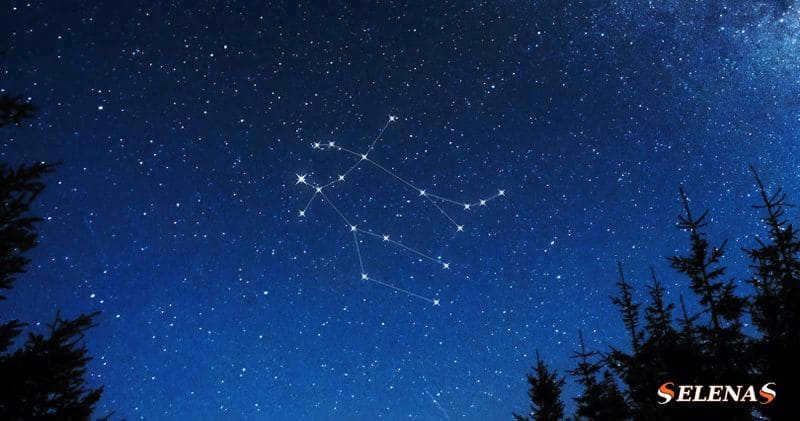
Gemini consists of 10 stars that have been given names.
The International Astronomical Union (IAU) has approved the following star names: Alhena, Alzirr, Castor, Jishui, Mebsuta, Mekbuda, Pollux, Propus, Tejat, and Wasat.
The constellation Gemini is associated with two meteor streams, namely the Geminids and the Ro-Heminids, and it is also home to one Messier object.
Gemini is notable for its various deep space objects, including the Eskimo Nebula, the Medusa Nebula, the NGC 2158 scattered cluster, and the Geminga neutron star.
Additionally, approximately 8 stars in Gemini have been confirmed to host exoplanets.
In Greek mythology, the constellation Gemini was associated with the twins Castor and Pollux.
The twins were born to Leda, the queen of Sparta, and are also linked to the Argonauts.
The brothers were also referred to as Dioscuri, meaning “sons of Zeus”.
However, in most versions of the story, only Polydeucus was Zeus’ son, while Castor was the son of Tyndareus, the mortal king of Sparta.
When Castor, the mortal brother, died, Pollux pleaded with his father Zeus to grant his brother immortality, and Zeus granted his wish, uniting them in the heavens.
The two brightest stars in the constellation, Alpha and Beta Gemini, represent the heads of the twins.
However, not everyone in ancient times identified the constellation as Castor and Polydeucus.
Hyginus and Ptolemy attributed the two stars to Apollo and Heracles, who were both half-brothers and sons of Zeus.
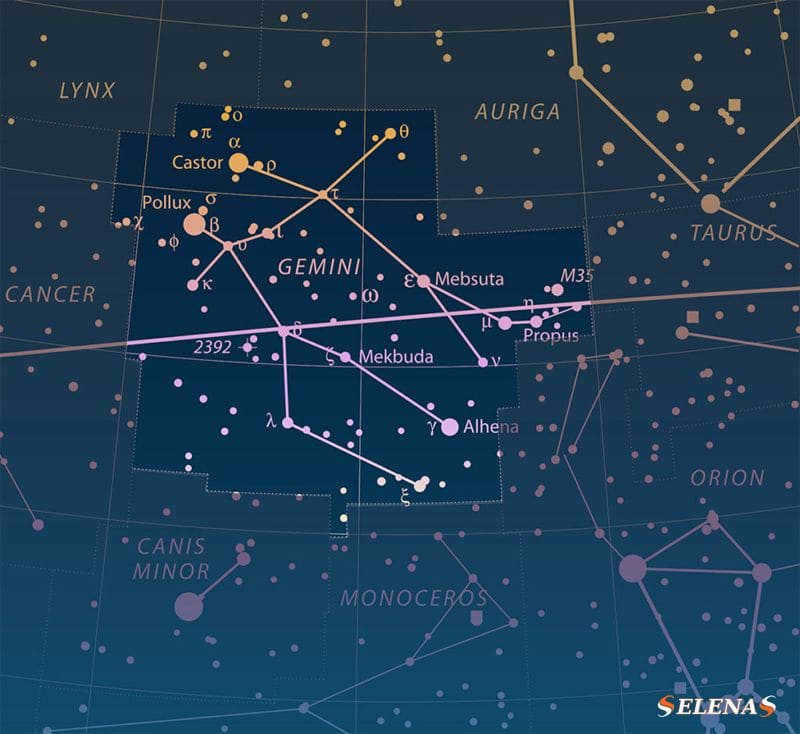
Position of the Gemini Constellation
As previously stated, Gemini is the 30th largest constellation visible in the night sky.
It occupies an area of 514 square degrees and is situated in the second quadrant of the northern hemisphere (NQ2).
It can be observed at latitudes ranging from +90° to -60°.
Its right ascension is 7 hours and its declination is +20°.
It is most favorable to view Gemini in February at 9 pm.
The Sun will traverse through Gemini from June 21 to July 20, 2062.
Gemini is a member of the zodiacal group of constellations, which also includes Aries, Taurus, Cancer, Leo, Virgo, Libra, Scorpio, Sagittarius, Capricorn, Aquarius, and Pisces.
Auriga (Auriga), Cancer (Cancer), Canis Minor (the Small Dog), Lynx (Lynx), Monoceros (Unicorn), Orion (Orion), and Taurus (Taurus) are the constellations that surround it.
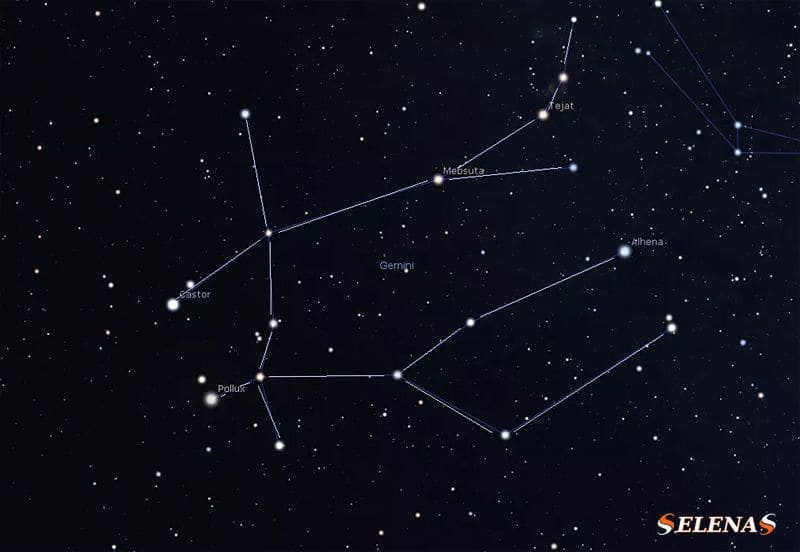
Well-Known Stars
Gemini is home to a number of well-known stars, with Pollux and Castor being the most renowned.
Pollux
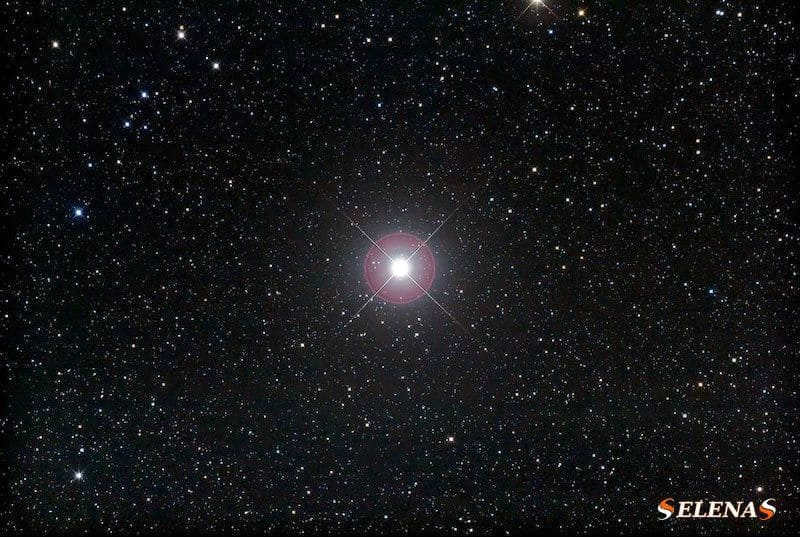
Pollux, also known as Beta Geminorum, is the most brilliant star in the Gemini constellation and the 17th brightest star in the night sky.
It is a mature orange giant classified as K0 III.
With an apparent magnitude of 1.14, Pollux is situated at a distance of 33.78 light-years from our solar system.
Pollux possesses a mass twice that of the Sun and a radius nine times that of the Sun.
In June 2006, the detection of an exoplanet called Pollux b revolving around this star was confirmed.
Pollux b has a minimum mass of 2.3 times that of Jupiter and completes one orbit every 590 days.
Beaver
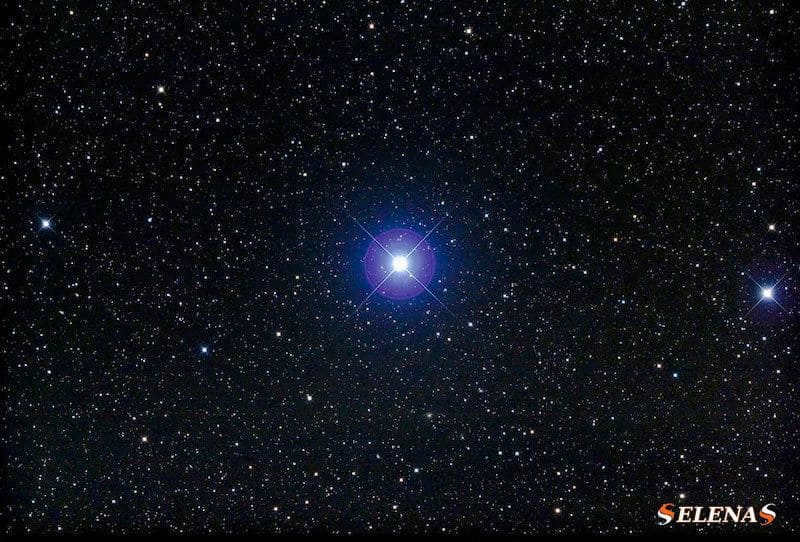
Castor, otherwise known as Alpha Geminorum, is the second most brilliant star in the Gemini constellation and the 44th most brilliant star in the sky.
It is a binary star with a combined apparent magnitude of 1.58.
The two components are separated by a distance of 6 inches and have an orbital period of approximately 467 years.
Each of Castor’s two components possesses a spectroscopic binary star, thus making Castor a quadruple star system.
Castor also possesses a faint companion located about 72″ away, which is a binary star system with an eclipse period of slightly less than one day.
Both components of the system are classified as red dwarfs (class M), thereby making Castor a hexastar system as all six of its components are gravitationally bound together.
The stellar classifications of the secondary component are A2 Vm and M2 V. The stars of the secondary component have stellar classifications of A2 Vm and M2 V.
Alhena (Alhena)
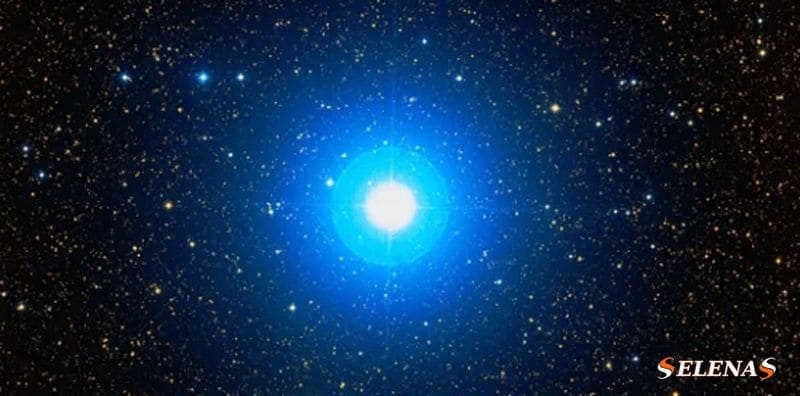
Alhena is also known as Gamma Gemini (Gamma Geminorum) and has a visible magnitude of 1.915, making it easily visible to the naked eye.
This star is classified as a white subgiant with a stellar classification of A1 IV and is located approximately 109 light-years away from our planet.
With a brightness that is about 123 times greater than that of the Sun, Alhena has a mass 2.8 times that of our Sun and a radius 3.3 times larger.
The name Alhena is derived from the Arabic term Al Han’ah, which translates to “branding” and refers to the branding on a camel’s neck.
In Arabic culture, it is also sometimes referred to as Almeisan, which means “shining”.
Mebsuta (Mebsuta).
Mebsuta, also identified as Epsilon Geminorum, is classified as a G8 Ib supergiant.
With a visual magnitude of 3.06, it is located approximately 840 light-years away.
Mebsuta can be found on Castor’s extended right leg.
This massive star possesses 19 solar masses and is 105-175 times larger in radius than our Sun.
It shines approximately 8,500 times brighter than our Sun.
Mebsuta is situated near the ecliptic plane and can be occulted by the Moon and planets.
The name Mebsuta is derived from the ancient Arabic word “Mabsuta,” which means “outstretched paw.”
It is sometimes referred to as Melbula or Melukta as well.
Tejat Posterior (Tejat Posterior)
Tejat Posterior, which is also known as Mu Geminorum (Mu Geminorum), holds the distinction of being the fourth most luminous star found within the Gemini constellation, boasting a visual stellar magnitude of 2.857.
This star is classified as a red giant and falls under the spectral class M3 III. Additionally, it is recognized as a slow irregular variable of type LB.
Tejat Posterior can be found approximately 230 light-years away from our current location.
Over a span of 72 days, the stellar magnitude of Tejat Posterior varies between 2.75 and 3.02, and it experiences a long-term oscillation period of 2000 days.
The star’s traditional name, which translates to “hind leg,” is derived from its association with the foot of Castor.
Tejat Prior (Tejat Prior).
Tejat Prior, also known as Eta Geminorum (Eta Geminorum), is a triple star system that consists of three components. It includes a spectroscopic binary star and a dwarf star of the G0 class, which orbits the binary pair with a period of more than 700 years.
This star system is situated approximately 350 light-years away from Earth and is located close to the ecliptic.
Occasionally, Tejat Prior may be eclipsed by the Moon and, on very rare occasions, by a planet.
The primary component of the binary system is a semiregular variable star and a red giant, classified as M3IIIlab. Its brightness can vary between 3.15 and 3.9 stellar magnitudes.
The secondary star is classified as spectral type B and has an orbital period of 8.2 years around the red giant.
Alzirr, also referred to as Xi Geminorum (Xi Geminorum), is a subgiant star of yellow-white color that falls under the spectral class F5 IV.
In Arabic, its name means “button,” and it is one of the four legs of the Gemini constellation.
With a magnitude of 3.35, it is sufficiently bright to be visible without the aid of binoculars.
Alzirr is located 58.7 light-years away from Earth and is approximately 11 times brighter than the Sun.
This star is rotating rapidly, with a projected rotational speed of 66 km/s.
It is thought to be a double system as indicated by spectroscopic analysis.
Wasat
Is there any way to rephrase the text so that it becomes unique, using the English language and preserving the HTML markup?
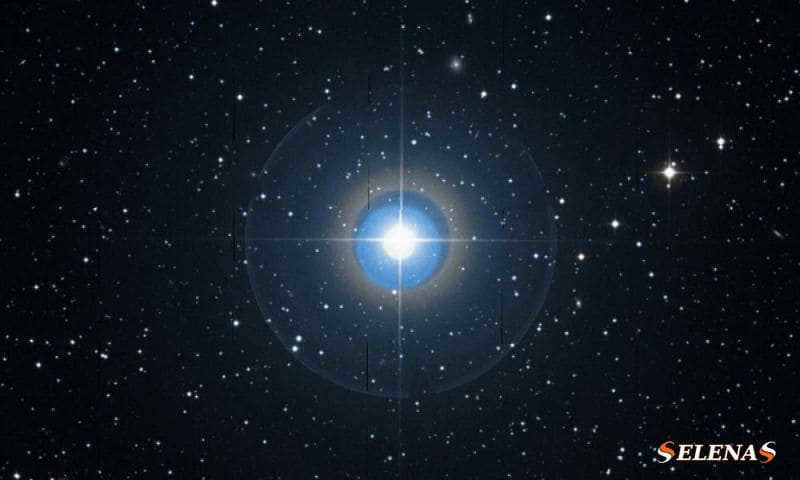
Delta Geminorum, also known as Wasat, is a subgiant star with a stellar classification of F0 IV. Its color is yellow-white.
With a visual stellar magnitude of 3.53, Wasat can easily be seen with the naked eye.
Wasat is located approximately 60.5 light-years away from Earth and is estimated to be around 1.6 billion years old.
Positioned just south of the ecliptic, Wasat occasionally gets blocked by the Moon and very rarely by planets.
Interestingly, Wasat is not a single star but a triple star system. The inner stars in the system form a spectroscopic double system, with an orbital period of 6.1 years.
Additionally, there is a K-class companion that orbits around the main component with an orbital period of 1200 years. This companion can be observed using a small telescope.
Delta Geminorum is an incredibly rapid rotator, spinning at a projected speed of 129.7 km/s.
The Arabic name for Delta Geminorum, Wasat, translates to “medium.”
Additionally, this star is sometimes referred to as Ta Tsun in Chinese.
Kappa Gemini (Kappa Geminorum)
Kappa Gemini is a multiple star system with a stellar classification of G8 IIIa.
Located approximately 143 light-years away from our solar system, Kappa Gemini boasts an apparent stellar magnitude of 3.57.
Furthermore, it shines 78 times brighter than the Sun.
Lambda Gemini (Lambda Geminorum)
Lambda Gemini is a variable star with an apparent magnitude of 3.58.
It falls into the spectral class A3 V and is estimated to be approximately 800 million years old.
Situated at a distance of around 94.3 light-years from Earth, this star shines 28 times brighter than our Sun and has a radius 2.8 times larger than that of the Sun.
Moreover, its mass is also 2.1 times greater than that of the Sun.
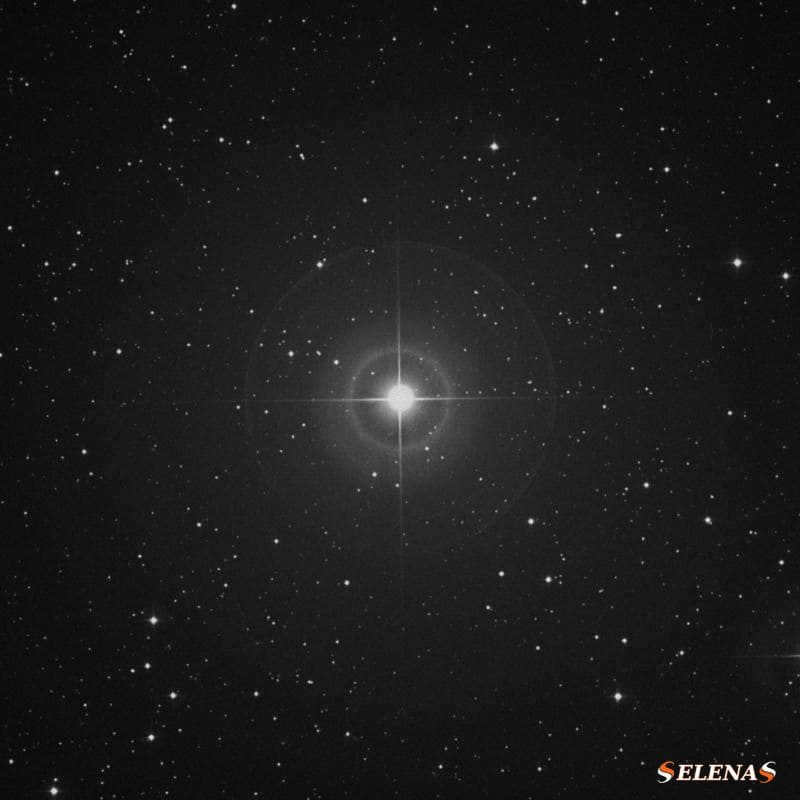
Propus, also known as Iota Geminorum (Iota Geminorum), is a member of the G9 III spectral class.
It has a visual magnitude of 3.78 and is located approximately 326 light-years away.
The Latin translation of its name is “front of the foot”.
Mekbuda.
Mekbuda, also known as Zeta Geminorum (Zeta Geminorum), is a supergiant of medium luminosity and is classified as a classical Cepheid variable star.
Its luminosity varies over a period of 10,148 days and its visual magnitude ranges from 3.68 to 4.16.
Mekbuda is approximately 2,900 times brighter than the Sun.
Its name is derived from ancient Arabic and means “the folded paw of a lion”.
Tau Gemini (Tau Geminorum).
Tau Gemini is classified as a K2 III orange giant.
Under optimal conditions, it can be observed without the need for binoculars.
With an apparent magnitude of 4.42, Tau Gemini is located approximately 321 light-years away from our solar system.
It shines 224 times brighter than the Sun and possesses twice the mass.
In addition, Tau Gemini has a radius 27 times that of the Sun.
Tau Gemini also has a companion known as Tau Gemini b, which is a brown dwarf.
Discovered in 2004, Tau Gemini b has a mass 18.1 times that of Jupiter.
It completes a full revolution around its host star in 305 days.
U Geminorum.
U Geminorum is a binary star system composed of a white dwarf and a red dwarf. It was first discovered by the British astronomer John Russell Hind in 1855. This star system undergoes periodic flares, resulting in a significant increase in brightness.
Located approximately 400 light-years away from our Sun, U Geminorum has an apparent magnitude that varies from 14.0 to 15.1. However, during a flare event, the system can reach a magnitude as bright as 9th, making it 100 times more luminous.
The two stars in the U Geminorum system orbit around each other with a period of 4 hours and 11 minutes. As they revolve, they continuously outshine each other.
Deep sky objects
Gemini is home to a variety of fascinating celestial objects, including nebulae and clusters.
Within the Gemini constellation, there is just one object designated by the Messier catalog.
Messier 35
Messier 35, also referred to as NGC 2168, stands as the sole Messier object within the Gemini constellation.
This cluster was discovered approximately 3,870 light-years away from Earth.
Astronomer Philippe Loys de Cheseaux (Philippe Loys de Cheseaux) made the discovery in 1745.
Messier 35 possesses an apparent stellar magnitude of 5.1, making it easily visible through a small telescope.
With a radius of about 11 light-years, it is estimated to be around 175 million years old and has a mass of roughly 1600 solar masses.
NGC 2158
NGC 2158 can be found in the southwestern direction of Messier 35, positioned approximately 11,000 light-years away from the Sun.
As an open cluster, NGC 2158 has a visible stellar magnitude of 8.6 and is estimated to have an age of around one billion years.
The Eskimo Nebula
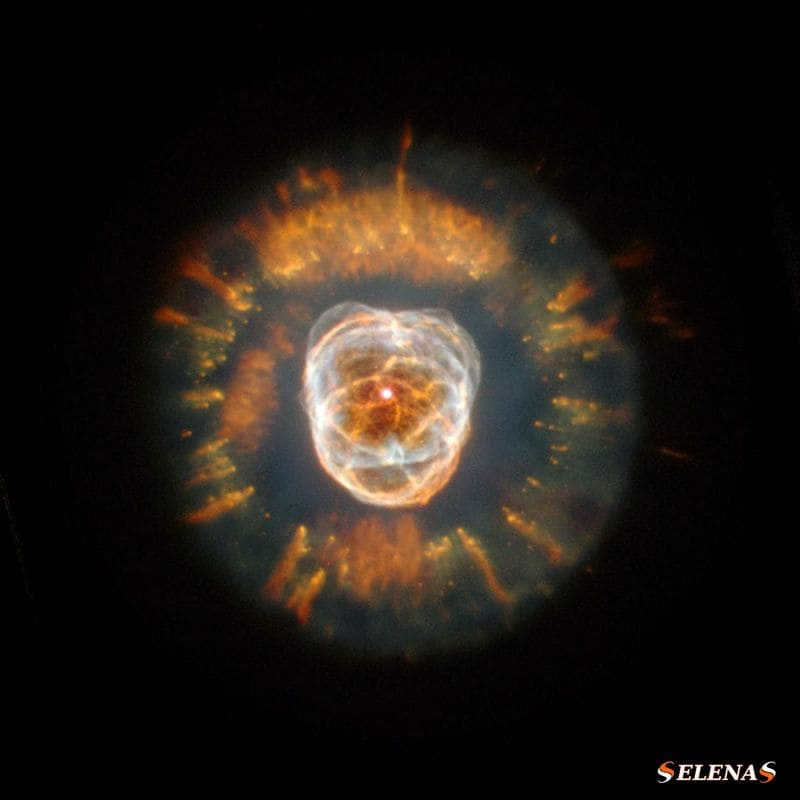
The Eskimo Nebula, which is also known as NGC 2392 and Caldwell 39, is a planetary nebula with a unique double-shell structure, surrounded by a layer of gas that was once part of a Sun-like star.
Occasionally, this nebula is also called the Clown Face Nebula.
With its apparent stellar magnitude of 10.1, the Eskimo Nebula can be observed using a small telescope.
Positioned approximately 2,870 light-years away from our solar system, it is a captivating celestial object.
The Nebula of the Jellyfish
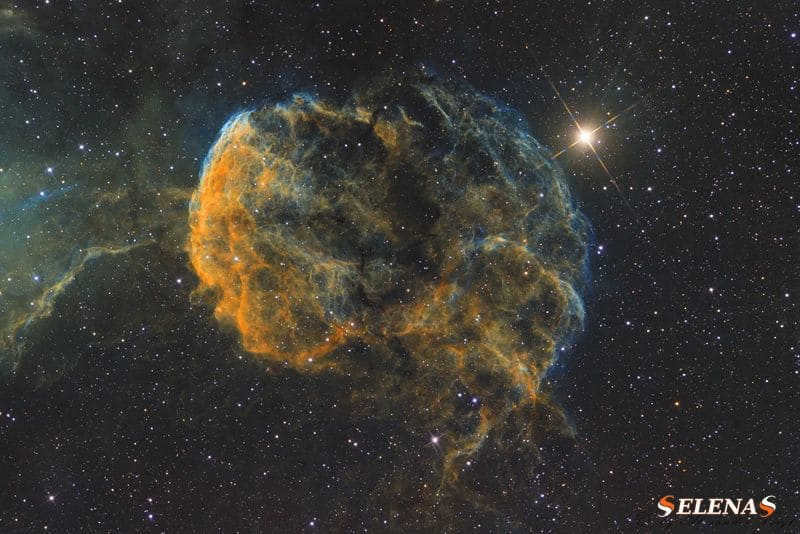
The Jellyfish Nebula, also called IC 443 or Sharpless 248, is a supernova remnant in our galaxy that can be found in the vicinity of the bright star Eta Gemini.
Situated approximately 5,000 light years away from Earth, this celestial object is believed to be the aftermath of a supernova explosion that took place between 3,000 and 30,000 years in the past.
Spanning approximately 70 light years in diameter, it is an incredible sight to behold.
The Medusa Nebula, also referred to as Sharpless 2-274 and Abell 21, can be found in the vicinity of the Little Dog (Canis Minor).
Back in 1955, the University of California, Los Angeles astronomer George O. Abell made the initial discovery of this planetary nebula, which is speculated to have a considerable age and size, measuring over four light-years in diameter.
With an apparent stellar magnitude of 7.68, it is roughly 1,500 light-years away from our solar system.
Initially, it was believed to be the remnants of a supernova.
However, during the 1970s, Soviet astronomers confirmed that it is more likely a planetary nebula.
The formation of this nebula occurred when a red giant transformed into a hot white dwarf, shedding its outer layers in the process.
Geminga.
Geminga is a pulsar that was discovered in 1972. A pulsar is a highly magnetized, rotating neutron star that emits beams of electromagnetic radiation out of its magnetic poles. It is believed to be the remnant of a massive star that exploded in a supernova about 300,000 years ago.
With an apparent stellar magnitude of 25.5, Geminga is not visible to the naked eye and can only be detected using telescopes. It is located approximately 815 light-years away from the Sun, making it relatively close in cosmic terms.
Geminga is notable for being the first pulsar to exhibit radio noise, which was discovered in 1982. Additionally, it was also the first gamma-ray source that could not be identified with any known astronomical object until it was confirmed to be a pulsar in 1991.
IC 444
IC 444 is a compact reflection nebula located in the Gemini constellation with an angular size of approximately 32 square minutes.
With an apparent magnitude of 7.03, it is relatively faint.
NGC 2129
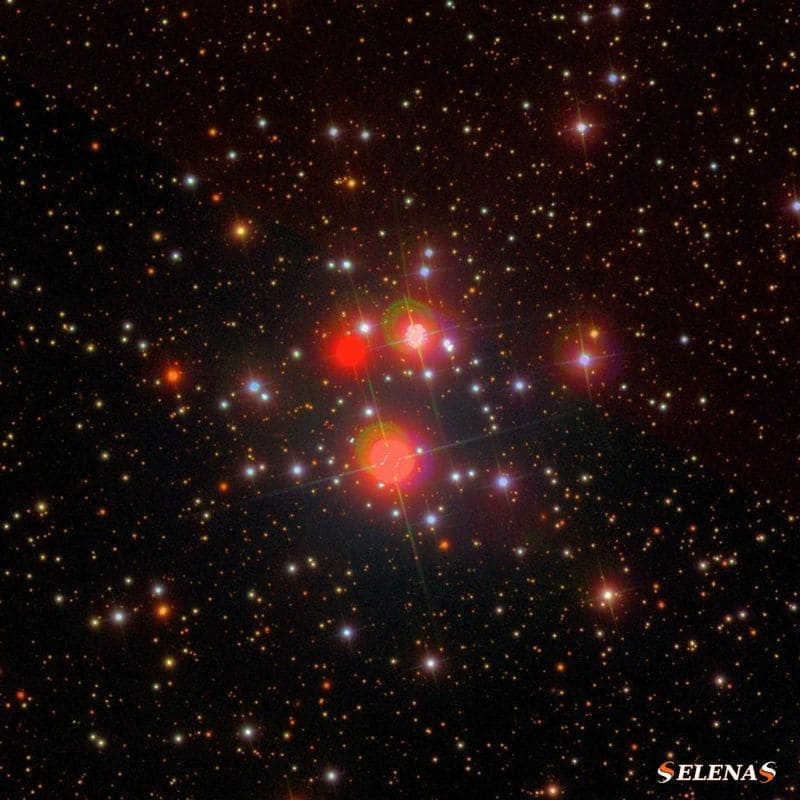
NGC 2129 is a youthful dispersed group with an evident stellar brilliance of 6.7.
It can be found roughly 7200 light-years away from the Sun, within the Local Spiral Arm, a minor spiral arm of the Milky Way.
The most dazzling stars within the group are two adjacent B-class stars, thought to be forming a binary system.
NGC 2129 is estimated to be around 10 million years old.
NGC 2371-2 is classified as a planetary nebula and exhibits a unique double-lobed structure, giving the impression of being two distinct entities.
As a result, the object is cataloged twice in the New General Catalog – NGC 2371 and NGC 2372.
Amateur astronomers have the opportunity to observe NGC 2371-2 through their telescopes. It is situated approximately 4400 light-years away from Earth, southwest of the prominent star Castor.
The credit for its discovery goes to William Herschel.
NGC 2355
NGC 2355 is a cluster of stars that is made up of ancient stars believed to be approximately one billion years old.
This cluster has a visual magnitude of 9.7 and is situated at a distance of about 5,400 light-years.
Meteor streams
There are two streams of meteors that are associated with the Gemini constellation, namely the Geminids and the Ro-Heminids.
The Geminids are exceptionally bright and reach their peak on December 13-14.
The Geminids are considered as one of the most abundant streams of meteors, with an estimated rate of about 100 meteors per hour during its peak.
The Ro-Heminids, on the other hand, reach their peak between October 18 and 29.
They coincide with the Orionids, which can make their detection challenging.
However, the Ro-Heminids have a higher velocity compared to the Orionids.
Interesting facts about Gemini
- From June 21 to July 20, the Sun appears in the constellation Gemini;
- According to tropical astrology, the Sun is considered to be in the sign of Gemini from May 21 to June 22;
- In Babylonian astronomy, the stars Castor and Pollux were known as the Great Twins. They were considered minor gods and were called Meshlamtaea and Lugalirra, which mean “He who rose from the underworld” and “The Mighty King” respectively;
- In Chinese astronomy, the stars of Gemini are located in two areas: the White Tiger in the West and the Scarlet Bird in the South.
If you have any questions or would like to leave a comment about this article, please feel free to do so in the comments section below.
See you soon! Come on in!
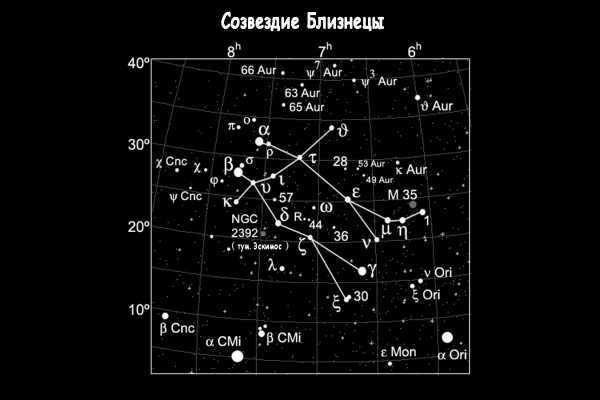
The Gemini constellation is known for its prominent stars, including Pollux and Castor. These stars symbolize the heads of the Dioscurus brothers, whose feet are positioned in the southwest direction. Located along the Milky Way and adjacent to Orion, these stars are approximately 4.5 degrees apart. Castor is a triple system, with its two bright components appearing as spectral doubles and the faint one as an eclipsing double.
Castor
Beaver
Woodchuck
Castor Fiber
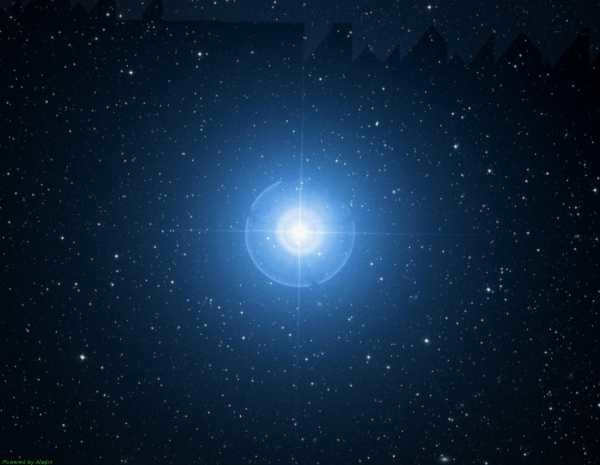
Castor is a group of six stars that come together to form a conjunction. These stars have a combined stellar magnitude of 1.59 and are located 45 light-years away from our Sun.
A computerized schematic of the Castor system is shown above.
The Castor system consists of two bright blue-white stars, each with stellar magnitudes of 2.7m and 2m. These stars are part of a double star system, with an angular distance of 6″ between them. They rotate around a single center of mass, completing one orbit every 400 years.
This clip, created using the Google 100,000 star app, provides a visual representation of the Castor system. Please note that the scale may not be accurate, but the animation is well-done.
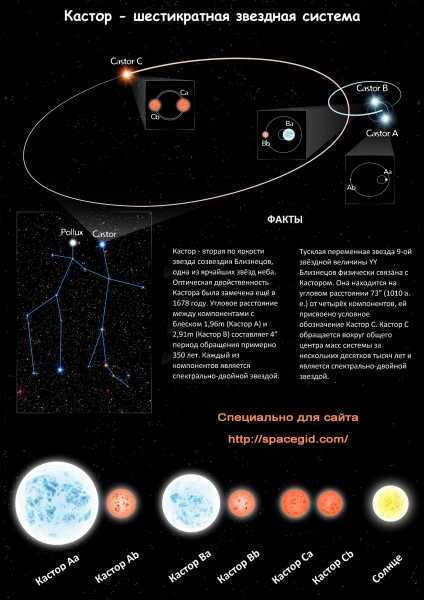
Castor, a sextuple star system, consists of two primary objects that emit a vibrant blue color.
Notable Sight
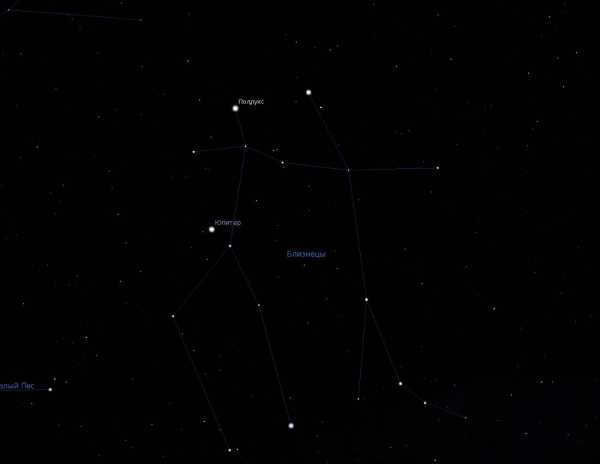
Using a large school refractor, one can easily observe that Castor consists of two blue stars, 2m and 2.9m, with a separation of 4.1″. As early as 1804, Herschel noticed the apparent orbital motion of this celestial object, with a period (according to current data) of 341 years. It was the first known double star. The distance between these stars is 76 astronomical units.
The A and B components of Castor also have a neighbor, the binary star C, which is located 73″ away from them (star 9m). Castor C is a small red-colored dwarf star with a double spectrum.
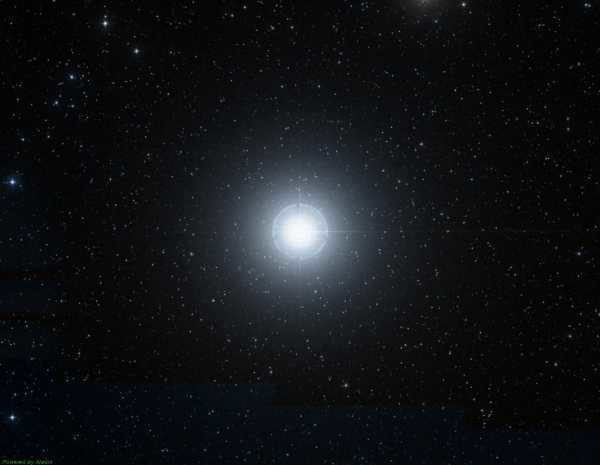
Pollux is a solitary star that emits a warm orange glow. In comparison to Pollux, Castor is positioned at a greater distance of 14 pc. Although Pollux may appear ordinary, it possesses a unique brilliance as a result of its proximity to us. On the other hand, Castor stands out as an exceptionally rare star system, as astronomers have limited knowledge about six-star systems.
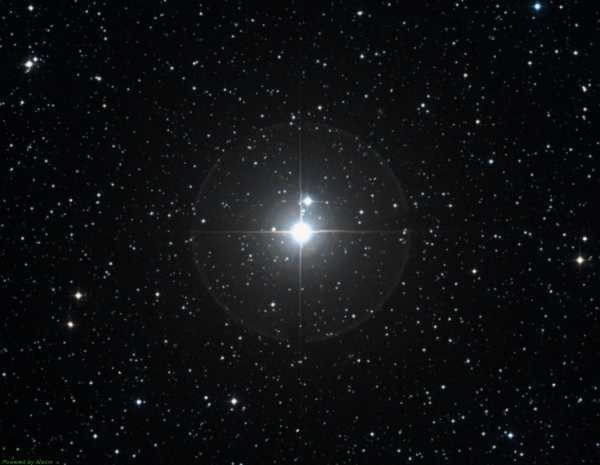
In the constellation Gemini, there are a pair of vibrant variable stars – the Gemini zeta, which exhibits its own brightness fluctuations from 3.9m to 4.3m, and the Gemini eta.
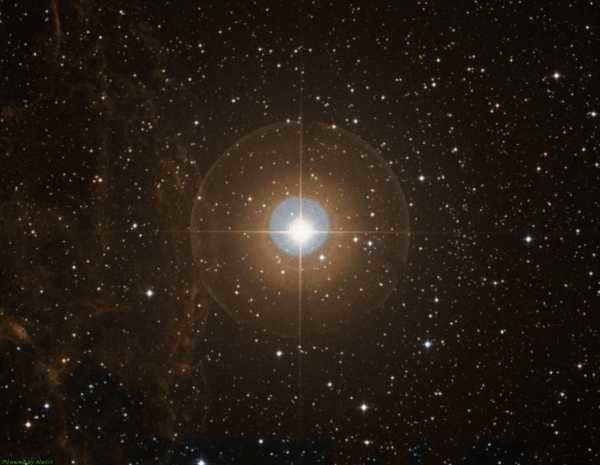
This particular Gemini, the second variable, is quite appealing due to its unique characteristics. It is not only an eclipsing variable but also a spectral double star. The star exhibits a fascinating period of 2984 days. Additionally, it showcases the qualities of a half-regular variable with an intermediate period of 233 days and an amplitude ranging from 3.1m to 3.9m.
Geminids
Located on the Paranal Plateau, which is the site of the impressive VLT telescope, the Geminids provide a breathtaking spectacle. This meteor stream is known for its incredible intensity and can be observed throughout the first part of December, with its peak occurring on the 13th and 14th of the month.
Historical Background
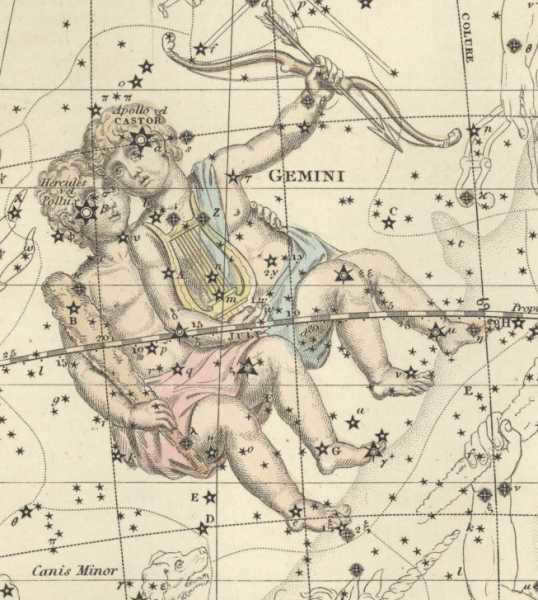
The constellation Gemini, depicted in an ancient celestial map
This group of stars has been recognized since ancient times. It is possible that the name “twins” was originally attributed to the nearby and resembling stars Pollux and Castor. According to Greek mythology, the constellation represented the twin brothers Dioscuri Polydeuces and Castor. In the literary work “Meeting of Divine Affairs” (16th century), the constellation was referred to as “Gemini”.

